The Transnational Access activities (TA1-10) offer a combined and integrated access to the largest collection of high-class experimental facilities for earthquake engineering in Europe – and worldwide – including reaction walls, shake tables, bearing testing facilities and centrifuges, to two facilities for integrated studies on geotechnical site effects and engineering seismology, and to a unique infrastructure in Europe for array seismology.
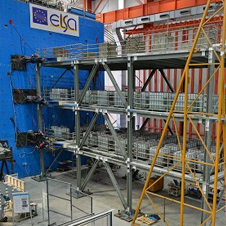
ELSA Reaction Wall at JRC
The European Laboratory for Structural Assessment (ELSA) was opened in 1992. It operates a reaction wall facility of unique dimensions and testing capabilities in Europe and worldwide. The ELSA team comprises 35 scientific and technical staff. It has developed and implemented the pseudo- dynamic (PsD) testing method and performed numerous large-scale reference tests. ELSA has become a world renowned reference for experimental research, fostering collaboration across EU laboratories, research centres and industry. ELSA operates a 16 m-tall, 21 m-long reaction wall, with two reaction platforms of total surface 760 m2 that allow testing real-scale specimens on both sides of the wall...
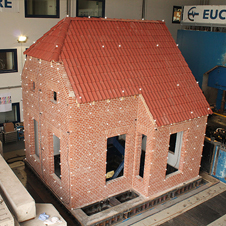
Shaking Table at EUCENTRE
The EUCENTRE Foundation, European Centre for Training and Research in Earthquake Engineering, based in Pavia (Italy), is a non-profit organisation that promotes, supports and sustains training and research in the field of seismic risk mitigation. Part of EUCENTRE is its experimental laboratory TREES Lab. This experimental facility has been specifically designed according to the most innovative technologies and thanks to its high performance equipment allows conducting both dynamic and static experimental research on full-scale prototypes. TREES Lab features four main experimental facilities, two of which are open for SERA Transnational Access: the high performance uniaxial Shaking Table and the bi-axial Bearing Tester System, designed for testing of full-scale...
> Read More | E-mail contact |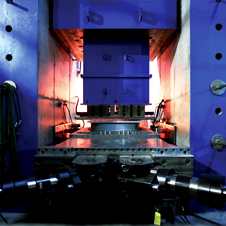
Bearing Tester System at EUCENTRE
The EUCENTRE bi-axial Bearing Tester System is designed for testing of full-scale bearing and isolation devices, with 5 degrees of freedom and with high dynamic and force capabilities: vertical force up to 50000 kN and horizontal force up to 2000 kN with horizontal displacement of ±480 mm. This experimental equipment is unique in Europe. During the test it is possible to dynamically control the vertical force and displacement and the rotations of the three principle axes, with the following specifications. The Bearing Tester System also features an additional component for the execution of full 3D tests (6 controlled DoF). With an alternative actuators configuration, the peak horizontal force can reach 2800 kN.
> Read More | E-mail contact |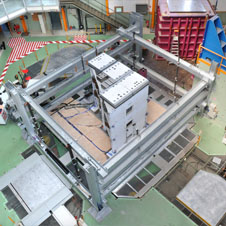
AZALEE Shaking Table at TAMARIS/CEA
The TAMARIS infrastructure and its main shaking table AZALEE, to which access is offered, belong to CEA’s Seismic Mechanics Study Laboratory (EMSI), who is leading the French SEISM Institute, is part of the Paris Saclay University regrouping about 19 academic partners and research institutes, and has international RTD collaborations with other facilities (EU, Japan, China, USA). The AZALEE shaking table, with 100t allowable model mass, is one of the largest shaking tables in Europe. To date, tests with masses up to 92t have been successfully performed. The shaking table is 6mx6m and 6 Degrees-of-Freedom (DoF), allowing testing specimens under independent excitations of various types: sinusoidal, random, shock and time-history with 0 to 100 Hz...
> Read More | E-mail contact |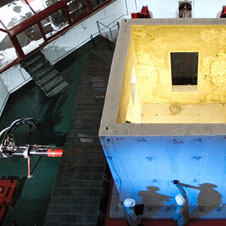
LNEC-3D Shaking Table
The infrastructure has a 5.6mx4.6m 3D shaking table (LNEC-3D), to which access is offered, located in a large testing hall with 10m height and an overhead crane with 400kN capacity, resulting in a versatile test facility that can be used for a variety of earthquake and dynamic load tests. The LNEC-3D shaking table (ST) has three independent translational degrees of freedom, with the rotational ones being passively restrained via a stiff torque tube system. The actuators allow for dynamic forces of 1000kN in the vertical and 700kN in the horizontal directions to be applied to the system, with peak velocities up to 0.7m/s and peak displacements of 0.2m in all directions. The control of the ST is fully digital, allowing input displacements of any form in a frequency...
> Read More | E-mail contact |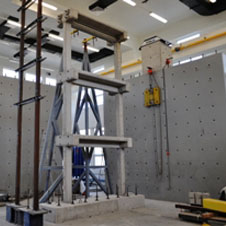
STRULAB Reaction Wall at University of Patras
The Structures Laboratory (STRULAB, 1991) is a facility of Civil Engineering Dept. of University of Patras. The Department academic personnel have an intense RTD activity in earthquake engineering since the 1980s. With the Univ. of Pavia, Grenoble and METU the Division awards MSc in Earthquake Engineering and Engineering Seismology to international and EU students through Erasmus Mundus MEEES project (www.meees.org). The Department is highly reputable in the area of Structures & Earthquake Engineering and is included in the top 150 departments worldwide (2014 QS World University Ranking list STRULAB research activity includes over 40 EC (e.g. as partner PREC8, ICONS, SAFERR, CASCADE, NODISASTR, LESSLOSS, SYNERG, EXCHANGE-SSI...
> Read More | E-mail contact |
EQUALS Shaking Table at University of Bristol
Laboratories for Advanced Dynamics Engineering (BLADE) in the Faculty of Engineering at the University of Bristol, UK. It houses a 15t capacity, 6 degree of freedom earthquake shaking table surrounded by a strong floor and adjacent strong walls up to 15m high (Figure 1). The shaking table is accompanied by a set of 40 servohydraulic actuators that can be configured to operate in conjunction with the shaking table, strong floor and reaction walls, providing a highly adaptable dynamic test facility that can be used for a variety of earthquake and dynamic load tests. A special feature of EQUALS is the digital control system. This has world leading features, including a ‘hybrid test’ capability in which part of the structural system of interest can be emulated...
> Read More | E-mail contact |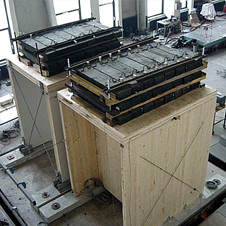
DYNLAB Shaking Table at IZIIS
The IZIIS’ Dynamic Testing Laboratory (DYNLAB) is part of the Institute of Earthquake Engineering and Engineering Seismology (IZIIS). IZIIS is one of the oldest institutes in the world of this type since it was established in 1965. In addition to the master studies, Ph.D. studies have also been carried out at the Institute. The Institute has a long tradition in organizing short- and long-term courses. Through the long-term courses, the Institute has trained over 520 candidates from 74 countries worldwide in the field of earthquake engineering and seismology. Considering basic research, the Institute took part in many national, bilateral, European projects (FP Framework Programme) as well as projects financed by NATO through the SfP Programme...
> Read More | E-mail contact |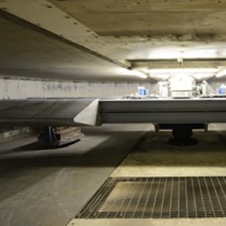
Centrifuge at University of Cambridge
The Schofield Centre is part of the Department of Engineering at University of Cambridge. It is housed at a separate site in the western part of Cambridge about 3 miles from the main department and is part of the Centre for Construction Process modelling. The Schofield Centre is a world-leading research centre for centrifuge modelling with 4 academics, 5 dedicated technical staff and offers training to about 30 PhD students and international visitors on various projects at any given time. The Schofield centre houses the 10 m diameter Turner beam centrifuge. This machine is 150 g-ton machine and can carry payloads of up to 1 tonne. It is routinely used to test soil-structure systems like buildings with pile foundations, retaining walls etc...
> Read More | E-mail contact |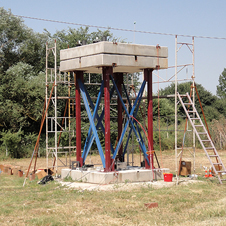
EUROSEISTEST and EUROPROTEAS
EUROSEISTEST combined with the EUROPROTEAS and its data providing web portal (http://euroseisdb. civil.auth.gr) is among the most powerful and advanced large-scale infrastructures in Europe and worldwide, supporting advanced research in earthquake engineering, geotechnical earthquake engineering, soil dynamics and seismology. It consists of a 3D array of 21 accelerographs and a large-scale model structure (EUROPROTEAS) dedicated to study soil-structure interaction and wave propagation for free and forced oscillation. EUROSEISTEST is the longest running (since 1993) test site of its kind at global scale and operates in the best known valley in the world, both from geometrical and geological-geotechnical point of view...
> Read More | E-mail contact |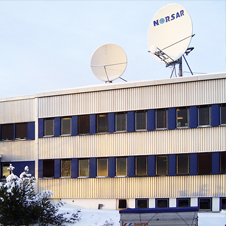
Array Seismology at NORSAR
NORSAR is the premier operator of seismological arrays in Europe and a worldleader in array seismology. The infrastructure at NORSAR consists primarily of a data centre and field installations on Norwegian territory and the European Arctic, comprising four different seismic arrays (with apertures ranging from 1 to 60 km equipped with 1C or 3C short-period or broadband sensors) and three single 3C broadband stations. NORSAR is an active partner in the Norwegian National Seismic Network, operates a other international institutions operating seismic arrays and stations in Northern Europe and the European Arctic. NORSAR provides access to its unique digital database of seismic recordings from all its installations reaching back to April 1971...
> Read More | E-mail contact |
